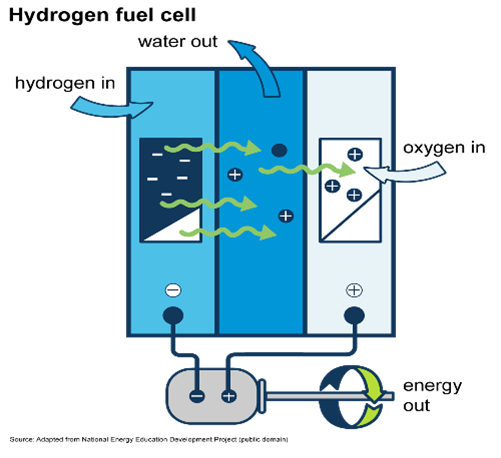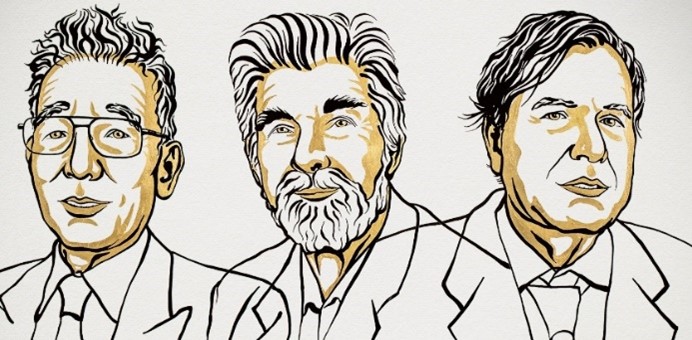Tuesday, 12th October 2021
Nobel Prize 2021 in Economics
In News
Three US-based economists David Card, Joshua Angrist and Guido Imbens have won the 2021 Nobel Prize for economics.
About the News
- The award has been granted for pioneering "natural experiments" to show real-world economic impacts in areas from minimum wage increases in the U.S. fast-food sector to migration from Castro-era Cuba.
- David Card was awarded for his empirical contributions to labour economics while Joshua Angrist and Guido Imbens for their methodological contributions to the analysis of causal relationships.

About the work
- Domain of research: The research challenged the conventional wisdom which used cause and effect relation to deal with big questions in social sciences.
- The Laureates showed that it is possible to answer these and similar questions using natural experiments.
- Outcome of their research:
- The result showed that the increasing the minimum wage does not necessarily lead to fewer jobs.
- The research also highlighted that high migration does not necessarily lead to negative wage or labour effects for host country residents with low levels of education.

Noble price in economics
- Unlike in medicine or other sciences, economists cannot conduct rigidly controlled clinical trials. Instead, natural experiments use real-life situations to study impacts on the world, an approach that has spread to other social sciences.
- The price is officially titled as "Sveriges Riksbank Prize in Economic Sciences in Memory of Alfred Nobel”.
- The price is announced each year and wasn’t established in the will of Alfred Nobel.
- Instead it was created in 1968 bya donation from Sweden's central bank Sveriges Riksbank to the Nobel foundation.
Sources:
Linear No-Threshold model for radiation safety
In News
The U.S. Nuclear Regulatory Commission (NRC) decisively upheld the Linear No-Threshold (LNT) model to prescribe radiation safety standards, ending the protracted controversy on the topic.
About the News
- About the Decision: The NRC’s view is that the LNT model continues to provide a sound basis for a conservative radiation protection regulatory framework that protects both the public and occupational workers.
- Despite the various studies cited by the petitioners, uncertainty and lack of consensus persist in the scientific community about the health effects of low doses of radiation.
- Convincing evidence has not yet demonstrated the existence of a threshold below which there would be no stochastic effects from exposure to low radiation doses
- The LNT model: It states that biological effects such as cancer and hereditary effects due to exposure to ionising radiation increase as a linear function of dose, without threshold.
- The LNT model helps the agencies to regulate radiation exposures to diverse categories of licensees, from commercial nuclear power plants to individual industrial radiographers and nuclear medical practices.
- Challenge to the theory: A group of researchers requested NRC “to amend its regulations based on what they assert is new science and evidence that contradicts the linear no-threshold (LNT) dose-effect model that serves as the basis for the NRC’s radiation protection regulations."
- The NRC denied the three petitions because they failed to present an adequate basis supporting the request to discontinue use of the LNT model.

Harmful effects of Nuclear Radiation

- As radioactive material decays, or breaks down, the energy released into the environment has two ways of harming a body that is exposed to it.
- It can directly kill cells, or it can cause mutations to DNA.
- If those mutations are not repaired, the cell may turn cancerous.
Sources:
Urbanization and Migratory Birds
In News
A 2017 study has observed how artificial light and other by-products of rapid urbanization threaten birds.
Observations of the Study
- About the Study: It was conducted using a bird collision dataset over a 21 year long period.
- Strong ties between bird mortality and artificial lighting: Artificial lights create a perception of a change in day length and lead to delayed births and the suppression of melatonin (a hormone responsible for the sleep-wake cycle).
- Nocturnal Bird Behaviour: Changes in the behaviour of nocturnally migrating birds in response to light stimuli was observed to disappear immediately after lights were switched off.
- Collision and associated factors: Collision driven mortality bears a strong correlation with migration traffic, the area of lighted windows in a building and local weather conditions.
- Low collision with Darkened Windows: In spring and autumn, collision rates were 11 and 6 times higher when windows were lit, as opposed to when they were darkened. Darkening a window even reduced collision incidences on nearby windows.
- Mitigation Measures: As switching off all the lights on all nights might not be commercially feasible, reducing light pollution for the largest 25% of migration events, leads to a reduction in collisions.
- Citizen-driven initiatives to switch off outdoor lights at night have gained traction in the recent past as it had reduced the number of bird collisions and had favoured the avian movement.
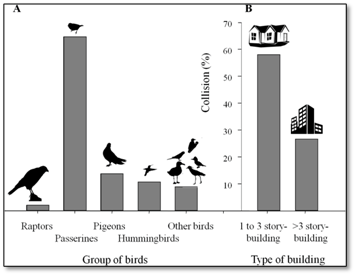
Cities and Avian Life
- Cities-the “no safe’ havens: Cities are no safe havens for avian life. Birds collide into buildings very often because windows reflect the surrounding environment or offer avenues that look open.
- Artificial Lights: Birds that have nocturnal migratory patterns (i.e. migrate by the night) are adversely affected by night lights of the city. These artificial lights can cause them to migrate too early or too late and miss ideal climate conditions for nesting, foraging and other behaviours.
- Distorted Migratory routes: Some migratory birds that are particularly vulnerable are those whose migratory routes pass through India that include common crane, bar-headed goose, falcon, northern wheatear, Amur falcon etc.
Sources:
The role of Police during the pandemic
In News
Data from the recently released Lokniti-CSDS and Common Cause report reveals that the nature of policing changed during the lockdown.
About the News
- Covid-19 created a range of unforeseen and unprecedented challenges for police across the world. The pandemic-induced lockdowns brought police personnel into direct contact with the people in need of urgent help and assistance, and to a large extent modified their primary role and nature of duties they used to perform in ‘normal’ times.
- Nearly 9 out of 10 police personnel (88%) felt that the nature of policing was different compared to normal times. Enforcing a lockdown was a whole new ball game, for which India’s police forces were neither well equipped nor trained.
What is the role of Police w.r.t. people?
- Police-public relations: According to Radelet, police-public relations mean, “the reciprocal attitude of the police and the public to the expected and performed tasks of the police, and to involve general public relations, community services, and community participation.
- The main basis for the relationship of the police and public, as it subsists today, is the Indian Police Act of 1861, which was legislated as a result of the approvals made by the Indian Police Commission of 1860.
- Role of Police: Police are one of the most ubiquitous organisations of the society. The policemen, therefore, happen to be the most visible representatives of the government.
- The police are expected to be the most accessible, interactive and dynamic organisation of any society. Their roles, functions and duties in the society are natural to be varied, and multifarious on the one hand; and complicated, knotty and complex on the other.
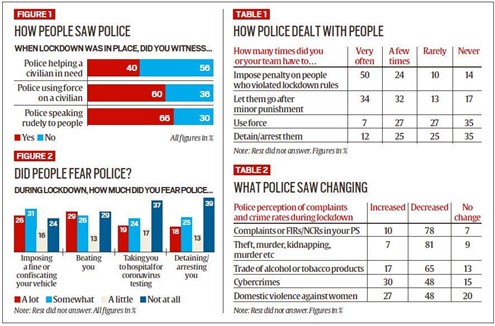
What was the change in the role and relationship of police w.r.t. common people?
Experience of the People with the Police
- Bitter-Sweet experience: The general public expressed a somewhat mixed opinion of the police’s behaviour during the lockdown. More than half (56%) witnessed the police providing help — but at the same time, about 1 in 3 (30%) reported the police were rude, and a nearly equal proportion (36%) said they saw them use force against civilians.
- Confrontations: It was the poor and those belonging to the lower and working classes who felt threatened more often and were more fearful of the police violence.
- The police personnel were equally more likely to complain that the working class localities were less compliant with the lockdown protocols.
- Surveillance: Almost three-fourths of police personnel admitted that the citizens were put under increased surveillance. The lockdown also resulted in a substantial decline in the incidence of crime though there was an increase in cybercrimes and cases of domestic violence.
- Positive Perception of Police: In spite of reports of excessive use of force, questionable arrests, and even custodial deaths in some parts of the country, the survey captured a largely positive public perception of the police during the pandemic.
- People were generally satisfied and felt secure with increased police presence and a majority believed that the lockdown rules applied equally to everyone.
How police saw things
- Mental Health of Police Personnel: A glaring but underreported aspect of policing during the pandemic was its impact on the cops’ mental health which affected almost all the respondents contacted.
- A large number of police personnel were unable to isolate themselves from other family members who often included the old and infirm or those with serious co-morbidities.
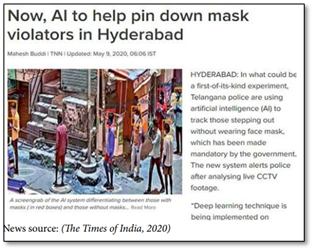
- Long Work Hours: Police personnel across the states reported working long hours (11 to 15 hours) daily and a majority identified lack of staff as a major hurdle in doing their job effectively..
- Role Expansion: The police during the pandemic became the most visible face of the government. The lockdown expanded their role even further by assigning them a number of non-policing duties like checking the body temperature or health reports, distributing food, rations, and supplies, contact-tracing through the ‘Arogya Setu’ App, managing the contamination zones, and arranging shelters for the migrant workers, among others
What are the new learnings about the Police?
- Police need to be trained for Crisis: Two things that stood out were an atmosphere of chaos and uncertainty and a lack of clarity about the additional roles and powers given to the police. The handling of the pandemic also uncovered the lack of training, SOPs, and general preparedness of the police in dealing with disasters.
- The idea of police reforms should not be a one-time event. It should be treated as a systemic and steady process requiring constant training, sensitisation, and capacity-building to suit the needs of a diverse, democratic nation.
- Need for Institutional mechanisms: Our experience of dealing with a pandemic of this magnitude strengthens the case for evolving more rational and broad-based responses, through institutional mechanisms and specific Acts of Parliament.
- Socio-administrative reforms: There is need to play close attention to improved caste, community and gender diversity in the force, increasing its sensitivity through regular training, putting safeguards in place against police excesses and brutalities, minimising discretion and ensuring equitable distribution of resources and facilities across rural, urban, Tier I, Tier II and III cities.
- All of the above will not be accomplished without improving the working conditions of the police.
- Technology Penetration: Despite the unprecendented reach of social media, the most widely used means of communication between the police and the people were loudspeakers. This restrictive and selective use of technology only for surveillance purposes instead of improved communication during the pandemic points to a glaring gap in the availability and application of resources.
- Institutional Memory: Practices and mechanisms must be developed for building institutional memory of all the lessons learnt while tackling law and order during a public health emergency and interacting with citizens during an extraordinary disruption.
- Building a preparatory knowledge base and establishing clear protocols for similarly unprecedented future events is an important task that the policymakers should focus on urgently.
- Community Policy: It needs to be prioritised and integrated into the police organisational ethos. Training academies reserve little time for community policing, but it is much needed in everyday field situations, and even more so in times of crisis.
Conclusion: Most of the areas of concern and shortcomings in the practices followed by the police during the lockdown are in fact pre-existing ailments of the system. These gaps have been highlighted time and again by reformers and advocates of the cause, but which got further exacerbated during the pandemic. If nothing else, these endemic shortcomings of the institution need to be addressed urgently through intensive structural changes. The findings of the study is a nudge to policymakers for overhauling several aspects of policing.
Question: Discuss the various aspects of Police’s role during the Pandemic. What are the learnings from these aspects?
Sources:
This Day in History - Dr. Ram Manohar Lohia
On 12 October 1967, Dr. Ram Manohar Lohia, one of India's greatest freedom fighters and socialist leaders, died. He was awarded a doctoral from Berlin University, Germany for his thesis paper on the topic of “Salt Taxation in India”, focusing on Gandhi's socio-economic theory. After returning to India, he co-founded the Congress Socialist Party (CSP) and edited its mouthpiece ‘Congress Socialist’. His vehement protests against enrolment of Indians in the Royal Army during World War II landed him in jail twice. During Gandhi's call of Quit India Movement, Lohia and his fellow CSP members, including Jayaprakash Narayan, put up resistance in stealth and were arrested. He was jailed again for writing an article 'Satyagraha Now’ in Gandhi's newspaper Harijan. After Independence, Lohia founded an organisation called ‘Hind Kisan Panchayat’ to help farmers with agricultural solutions. He had also protested against the Portuguese government's policy of restricted speech and movement of natives in Goa. Lohia made a case for Hindi to be the official language of India after Independence.

Source:
Image of the Day - Biosymbiotic device
This is image of wearable device they call a “biosymbiotic device. This can be used to make wearable devices which are entirely 3D-printed, wireless and personalized. Current wearable sensors face various limitations. By using 3D scans of a wearer's body, which can be gathered via methods including MRIs, CT scans and even carefully combined smartphone images, a biosymbiotic device can be 3D-print custom-fitted devices that wrap around various body parts. Because these devices are custom fitted to the wearer, they're also highly sensitive. It is made out of lightweight, breathable material. Previous wearable technologies included patches that stick to the skin, but they come off when skin goes through its normal shedding process or sweating. The biosymbiotic device uses no adhesive and hence it does not come off when the skin is shed. Also, it receives its power from a wireless system with a range of several meters. The device, in addition, includes a small energy storage unit, so that it functions even if the wearer goes out of the system’s range, including out of the house.

Source:
Transplanted Liver Reused
• Context: A liver has been reused and transplanted in a new recipient for the first time Delhi, India.
• A liver transplant is a surgical procedure that removes a liver that no longer functions properly (liver failure) and replaces it with a healthy liver from a deceased donor or a portion of a healthy liver from a living donor.
• The liver is the largest internal organ and performs several critical functions that include:
o Processing nutrients, medications and hormones
o Producing bile, which helps the body absorb fats, cholesterol and fat-soluble vitamins
o Making proteins that help the blood clot
o Removing bacteria and toxins from the blood
o Preventing infection and regulating immune responses
• In a first of its kind operation, doctors at Delhi hospital have reused a liver transplanted onto a patient who was declared brain dead days after the operation to save another man’s life.
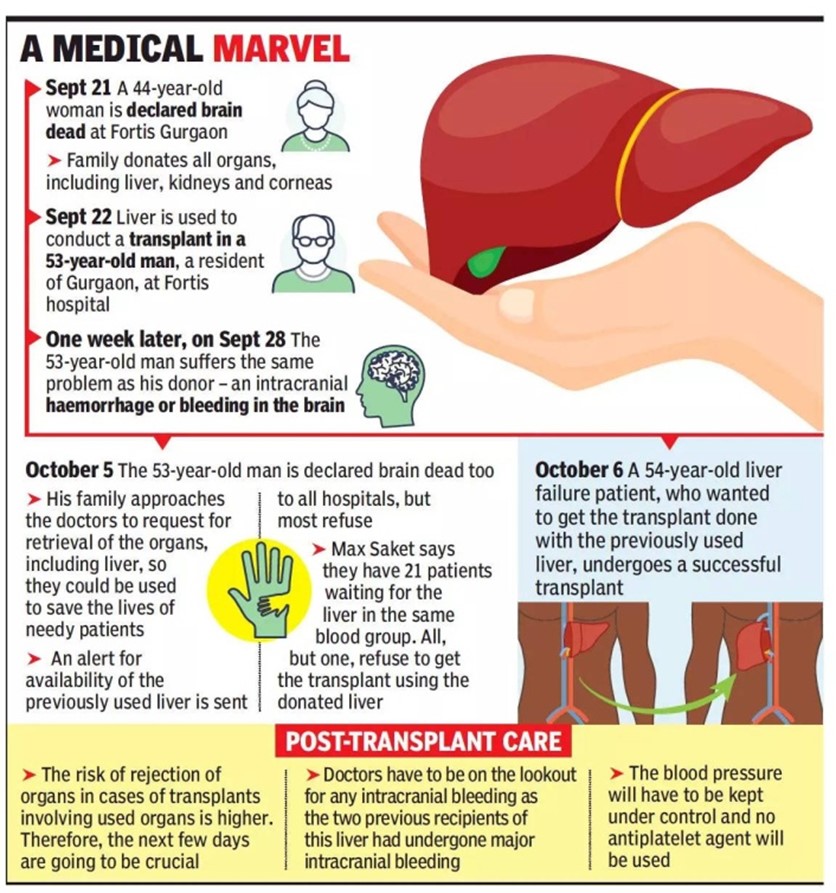
Sources:
Image Source:
Eco Oscars
- Context: Two projects from India will be among the 15 projects competing in finals for the Eco Oscars.
- The Earthshot Prize aka Eco Oscars is an award that five finalists will receive between 2021 and 2030 for developing solutions to fight climate crisis.
- The awards were established by UK’s Prince William and natural historian David Attenborough in 2020.
- This year awards will be handed out to finalists for their contributions towards the five UN Sustainable Development Goals namely:
- Restoration and protection of nature
- Air cleanliness
- Ocean revival
- Waste-free living and
- Climate action.
- The Earthshot Prize awards one million euros to the five individuals or organizations that have come up with impactful solutions to problems plaguing the planet

Sources:
Kalapani
- Context: The territorial dispute over Kalapani is expected to be solved through dialogue between India and Nepal.
- The valley of Kalapani in Pithoragarh district of Uttarakhand, with the Lipulekh Pass at the top, forms the Indian route to Kailash-Manasarovar which is an ancient pilgrimage site.
- The territory represents the basin of the Kalapani River, one of the headwaters of the Kali River in the Himalayas.
- Kalapani is a 372-sq km area at the China-Nepal-India tri-junction. India claims Kalapani as a part of Uttarakhand while Nepal depicts the area in it map. The border dispute flared up again recently after India released its new political map, following the reorganization of J&K, showing the area as its own. The original dispute is rooted in the Sugauli Treaty signed between Nepal and British in 1816, and it’s different interpretation by both the countries.
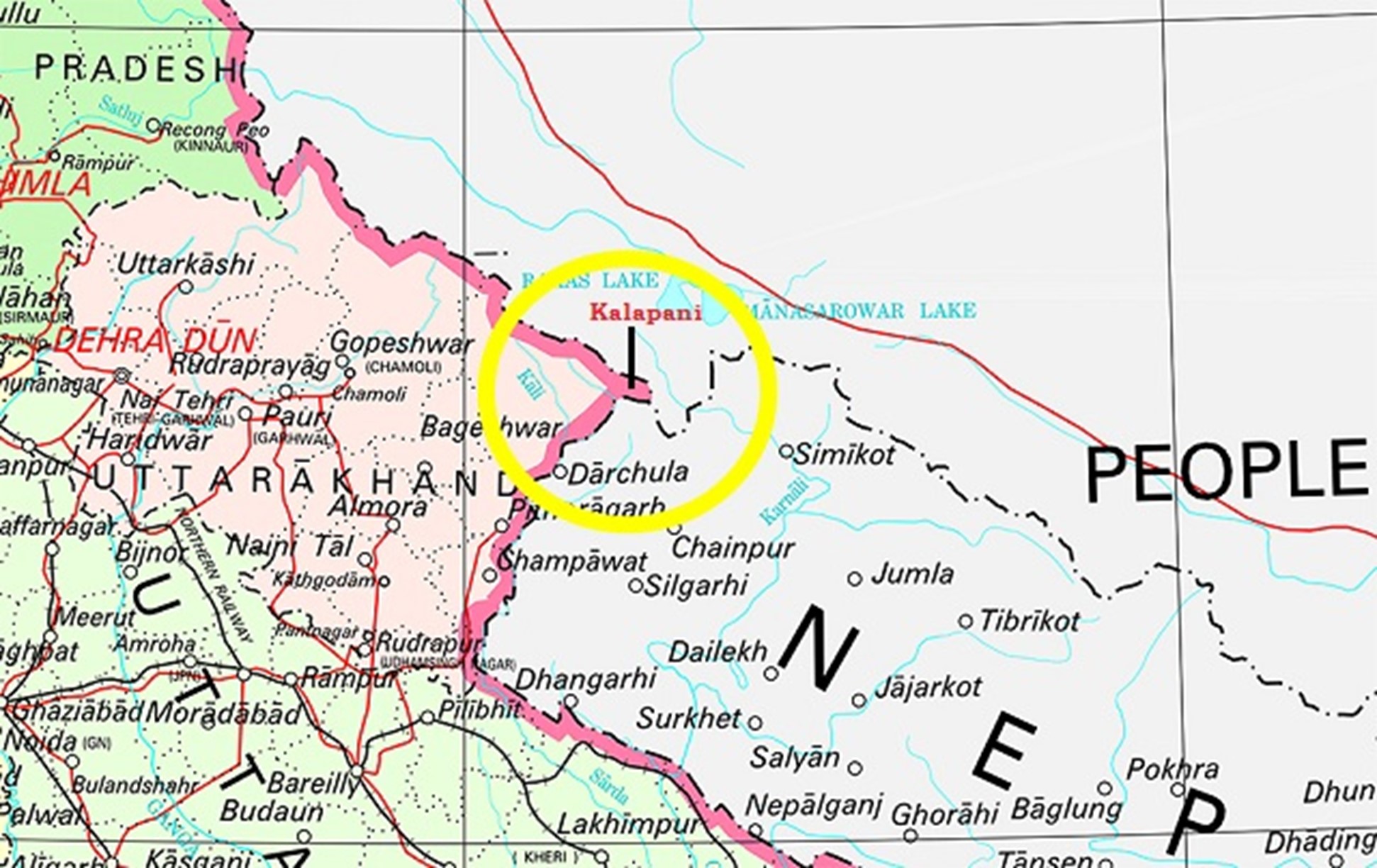
Sources:
Moth Species
• Context: A recent study on insect diversity has identified 338 moth species from 32 families spanning 14 super families in Delhi.
• Moths are an important part of the food chain as they are the primary food source for vertebrate insectivores, including birds, bats and lizards.
• They are important pollinators of diverse agro-ecosystems.
• They are nocturnal and are strongly attracted to artificial light (positive phototaxis). This affects various aspects of the moths such as behavior, physiology, dispersal activity and reproduction.
• Artificial light acts as a feeding suppressant by withdrawing the larvae from host plants towards the light source causing decreased larval development.
• Silver-striped Hawkmoth, a nocturnal moth, Coffee Bee Hawkmoth, a diurnal hawkmoth, Asota moths (important bioindicators), and the adult moth, known as bee robber that steals honey from hives were the moths that were recently sighted.
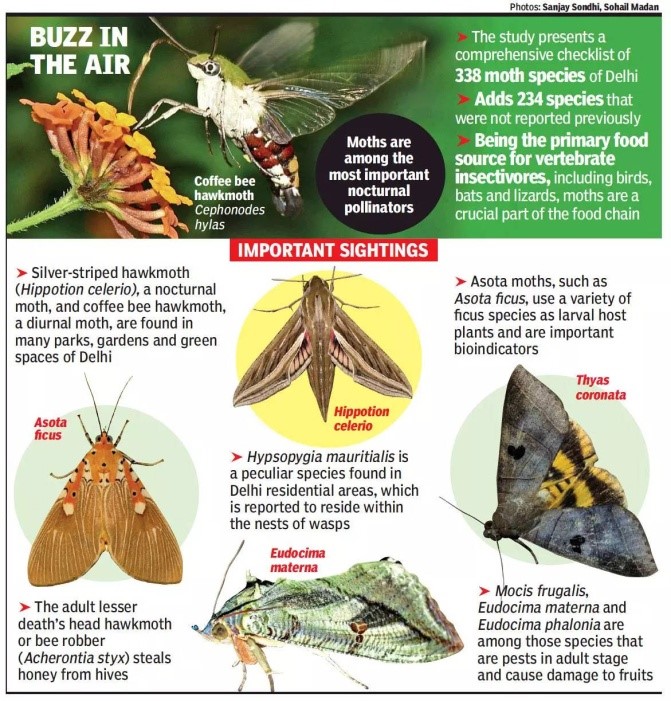
Sources:
How to get farmers to not burn crop residue: IE
Essence: Stubble burning to clear fields for the winter wheat sowing season is a health and an environmental hazard. A study of crop residue management revealed that farmers view the alternatives to burning and subsidy on equipment for crop residue management are not financially viable. It also revealed that partial upfront cash transfers build trust and it should cover their costs of managing stubble without burning.
In light of the study, effective ways of dealing with crop burning are conditional cash payments and subsidizing ex-situ equipment (operation of biogas plants) as farmers prefer ex-situ method of crop residue management. These would bring larger benefit to the society.
Why you should read this article?
- To understand the perceptions of farmers on solutions to stubble burning.
- To understand effective solutions to stubble burning.
Source:
How Delhi came to see Europe as a valuable strategic partner: IE
Essence: The article talks about the in-person summit of New Delhi with the Danish Prime Minister, and emphasizes the importance of strategic and diplomatic relations with the European Union. In the same realm, it mentions Europe’s Indo-Pacific strategy with New Delhi which has seemingly been overshadowed by the AUKUS alliance. Amidst the crisis between the USA and China, Europe has stood out as the best platform for not only India, but Asia as well to cultivate and grow together. India’s EAM mentions of ‘cultivating Europe’ as one of the foreign policy strategies where he explains it as giving equal attention to Brussels which was neglected in the past. On the other hand, Europe sees this relationship as an opportunity to work in coordination with the Quad in Indo-Pacific and engage with other Asian nations..
Why you should read this article?
• To understand the vitality of Europe’s relationship with India to foster in Indo-Pacific.
• To understand how Europe and India together can foster a challenge to AUKUS.
Source:
Tackling the climate crisis: TH
Essence: According to various reports, India is likely to face rise in weather extremes in the future and the seventh-most affected county due to climate change. Though India is doing well in achieving its mitigation commitments but with escalating climatic risks, a development-centric approach taking regional specificities into consideration is needed. Article further suggests several steps that India can take to strengthen adaptation and resilience further. Proactive and timely need-based adaptation with collaborative approach is the key to create a sustainable economy.
Why should you read this article?
- To get an overview of climate change and its impact on India.
- To understand what possible steps needs to be taken to tackle the same.
Source:
A New World Education: Mentorship as the Key
Background
- At the time of the pandemic, when everyone is juggling through and online- offline dilemma, Delhi Government has launched an initiative for the senior school students.
- The initiative called as ‘Desh ke Mentor’ aims to cover for around 9 lakh students of Delhi Government schools in 9th-12th

About the Mentorship Programme
- Aim: Providing students with non-judgemental helping hand, someone with whom they can talk with any inhibitions.
- Individual Guidance: Better outcome due to individual importance and attention given to the student.
- Pan -India Mentors: Mentors can be initiated from all over India through simple registration on the Delhi Government app.
- Nation building: An initiative for better citizen by bridging the societal gap eradication caste and religion barriers.
Quote:
“The delicate balance of mentoring someone is not creating them in your own image, but giving them the opportunity to create themselves.” — Steven Spielberg
Source:
Share the article
Get Latest Updates on Offers, Event dates, and free Mentorship sessions.

Get in touch with our Expert Academic Counsellors 👋
FAQs
UPSC Daily Current Affairs focuses on learning current events on a daily basis. An aspirant needs to study regular and updated information about current events, news, and relevant topics that are important for UPSC aspirants. It covers national and international affairs, government policies, socio-economic issues, science and technology advancements, and more.
UPSC Daily Current Affairs provides aspirants with a concise and comprehensive overview of the latest happenings and developments across various fields. It helps aspirants stay updated with current affairs and provides them with valuable insights and analysis, which are essential for answering questions in the UPSC examinations. It enhances their knowledge, analytical skills, and ability to connect current affairs with the UPSC syllabus.
UPSC Daily Current Affairs covers a wide range of topics, including politics, economics, science and technology, environment, social issues, governance, international relations, and more. It offers news summaries, in-depth analyses, editorials, opinion pieces, and relevant study materials. It also provides practice questions and quizzes to help aspirants test their understanding of current affairs.
Edukemy's UPSC Daily Current Affairs can be accessed through:
- UPSC Daily Current Affairs can be accessed through Current Affairs tab at the top of the Main Page of Edukemy.
- Edukemy Mobile app: The Daily Current Affairs can also be access through Edukemy Mobile App.
- Social media: Follow Edukemy’s official social media accounts or pages that provide UPSC Daily Current Affairs updates, including Facebook, Twitter, or Telegram channels.


